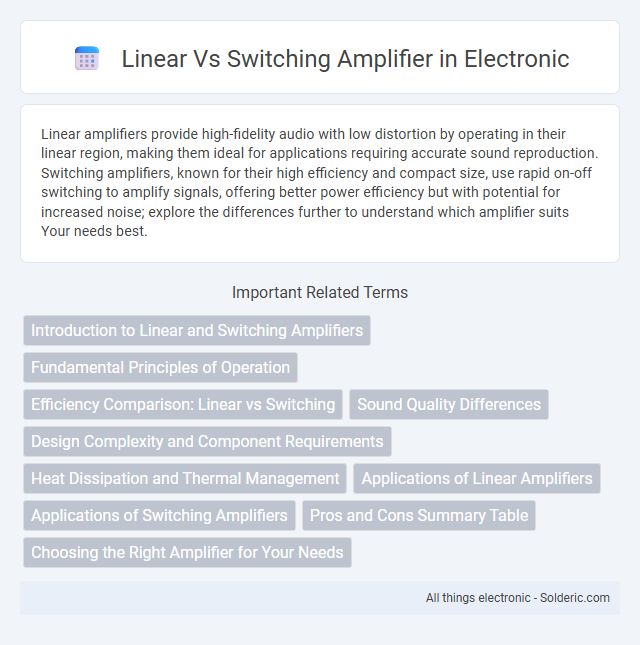Linear amplifiers provide high-fidelity audio with low distortion by operating in their linear region, making them ideal for applications requiring accurate sound reproduction. Switching amplifiers, known for their high efficiency and compact size, use rapid on-off switching to amplify signals, offering better power efficiency but with potential for increased noise; explore the differences further to understand which amplifier suits Your needs best.
Comparison Table
| Feature | Linear Amplifier | Switching Amplifier |
|---|---|---|
| Operation Mode | Continuous conduction in linear region | ON/OFF switching operation |
| Efficiency | Low (typically 20-60%) | High (up to 90% or more) |
| Heat Generation | High due to power loss | Low due to efficient operation |
| Signal Distortion | Low distortion, high fidelity | Potentially higher distortion, needs filtering |
| Complexity | Simpler design | More complex circuitry |
| Cost | Generally lower | Generally higher |
| Applications | Audio amplification, RF amplifiers | Power supplies, audio amps (Class D), RF transmission |
Introduction to Linear and Switching Amplifiers
Linear amplifiers operate by continuously varying output voltage or current proportionally to the input signal, resulting in high fidelity and low distortion amplification ideal for audio and radio frequency applications. Switching amplifiers, also known as class D amplifiers, use transistors as switches that rapidly toggle on and off to modulate the output, offering significantly higher efficiency and less heat dissipation compared to linear amplifiers. The choice between linear and switching amplifiers depends on performance requirements such as efficiency, linearity, and signal fidelity specific to the application.
Fundamental Principles of Operation
Linear amplifiers operate by continuously varying the output transistor's conduction to produce a faithful, analog reproduction of the input signal, maintaining low distortion and high linearity. Switching amplifiers, or Class D amplifiers, function by rapidly switching output devices fully on or off, modulating the pulse width to represent the input waveform, which results in high efficiency and reduced heat dissipation. The fundamental difference lies in linear amplifiers' analog signal amplification versus switching amplifiers' pulse-width modulation technique.
Efficiency Comparison: Linear vs Switching
Switching amplifiers typically achieve efficiency levels above 80% by rapidly toggling between on and off states, minimizing power loss as heat. Linear amplifiers generally operate at efficiencies between 20% and 30%, since they continuously dissipate power in the output transistors to maintain signal fidelity. Understanding this efficiency gap can help you select the right amplifier type for applications needing power savings or sound quality.
Sound Quality Differences
Linear amplifiers deliver high-fidelity sound with minimal distortion and a more accurate reproduction of audio signals, making them ideal for audiophiles seeking pure sound quality. Switching amplifiers, though more energy-efficient and compact, often introduce higher levels of harmonic distortion and noise, which can affect sound clarity and warmth. The choice between the two depends on the listener's priority for sound precision versus efficiency and form factor.
Design Complexity and Component Requirements
Linear amplifiers feature simpler design architectures and require fewer components, making them easier to implement but often less efficient. Switching amplifiers involve more complex circuitry with additional components like transistors and inductors to achieve higher efficiency and power output. Your choice depends on design priorities such as simplicity versus performance and power efficiency.
Heat Dissipation and Thermal Management
Linear amplifiers generate significant heat due to their continuous operation in the active region, requiring robust heat sinks and active cooling systems to maintain thermal stability. Switching amplifiers operate at high efficiency with minimal power loss, drastically reducing heat dissipation and simplifying thermal management requirements. Efficient thermal design in switching amplifiers improves reliability and performance by preventing overheating and maintaining optimal operating temperatures.
Applications of Linear Amplifiers
Linear amplifiers are widely used in high-fidelity audio systems, radio frequency transmission, and instrumentation where signal integrity and low distortion are critical. Their application in RF communication includes AM, FM, and SSB transmitters due to their ability to amplify analog signals without introducing significant nonlinearities. Precision measurement devices and medical equipment also rely on linear amplifiers for accurate and stable signal amplification.
Applications of Switching Amplifiers
Switching amplifiers, widely used in wireless communication systems and audio amplification devices, deliver high efficiency by rapidly toggling output transistors between on and off states. Their applications extend to power supplies in renewable energy systems and electric vehicle motor drives, where minimal power loss and thermal management are critical. Additionally, switching amplifiers enable compact design in radio frequency (RF) transmitters and digital audio processors, making them essential for modern electronic devices requiring efficient power conversion.
Pros and Cons Summary Table
Linear amplifiers offer superior audio fidelity and low distortion, making them ideal for high-quality sound applications, but they tend to be less efficient and generate more heat. Switching amplifiers provide higher efficiency and compact size, which benefits portable and battery-powered devices, but they may introduce electromagnetic interference and audio artifacts. Your choice depends on whether you prioritize sound clarity or power efficiency, as summarized in the pros and cons table.
Choosing the Right Amplifier for Your Needs
Linear amplifiers offer high-fidelity audio with low distortion, making them ideal for applications where sound quality is paramount. Switching amplifiers provide greater efficiency and compact size, suitable for battery-powered devices or where heat dissipation is a concern. Your choice depends on prioritizing either audio precision or power efficiency based on your specific usage requirements.
Linear vs Switching amplifier Infographic

 solderic.com
solderic.com